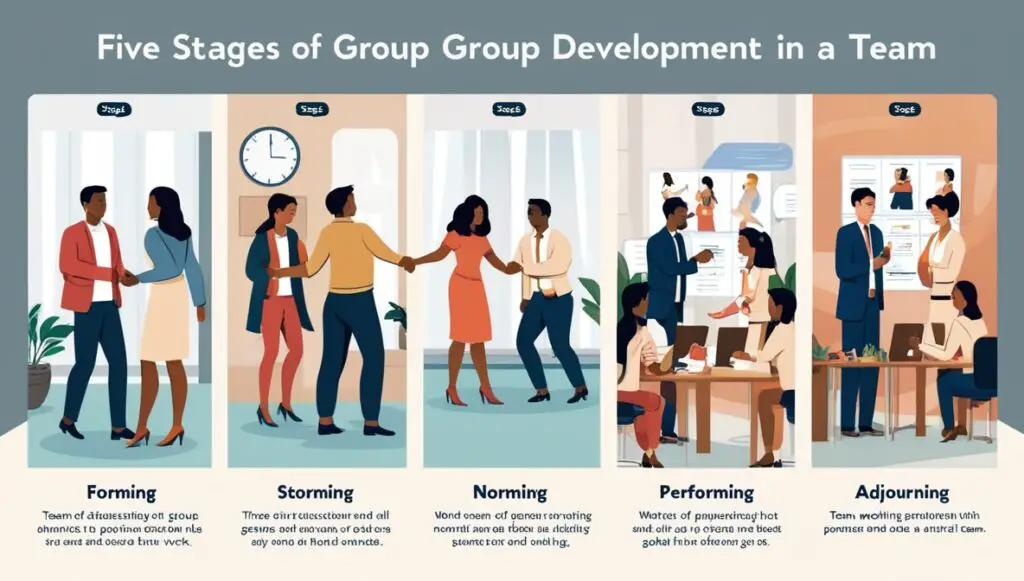Group Development
Before describing Tuckman’s stages of group development, it is essential to understand the nature of group. When people meet as a group, they go through stages. These stages may occur even over one meeting. If the group continues to meet regularly, it will go through stages with particular characteristics. This is sometimes called the life cycle development of a group.
Life Cycles
A group’s life cycle begins, middles, and ends. Initially, group members decide what they can do and accomplish together and set restrictions for themselves and the group. The middle phase builds on first impressions. Because the group values its work, it develops understanding and solves problems.
Lastly, this includes saying farewell, realizing they’ve done all they can, deciding to move on, celebrating success, admitting what remains to be done, and acknowledging the group’s relationships.
Model of Group Development
The ideas that inform the following models of group development should enhance the facilitator’s understanding of the group’s process. Remember, as with individuals, all groups are unique. No group will correspond directly to any model. All groups will move through the phases outlined below, but not necessarily in the same order.
Groups can and do move backward as well as forward. Within any one phase, a group might have an internal cycle during which it goes through yet other phases or stages.
Bruce W. Tuckman’s (1965) model of the developmental process has been the most influential, certainly when it comes to its influence on texts targeted at professionals. Although there are some variations in the number of stages and their names, many have embraced a version of Tuckman’s model—forming, storming, norming, and performing. He was later to add a fifth stage—adjourning—in 1977 (Tuckman and Jensen 1977). First, let’s examine his initial formulation.
Stage 1 – Forming
Members’ Needs: to be comfortable within the group, safe, and to know and share information.
Forming is the first stage, also known as orientation, when the group members have just met. Feelings of uncertainty and anxiety prevail, with limited self-disclosure. Group members tend to rely on the leader, who provides structure and space for members to share their hopes for the group.
At this stage, members are learning what to do, how the group will operate, what is expected, and what is acceptable. During the forming stage, it is important to consider various aspects such as the group’s purpose, organization, responsibilities, milestones, rules, and available resources.
The title of this stage conveys the socio-emotional and task issues that concern group members. In the initial stage, the predominant socio-emotional issue is inclusion, referred to as approach-avoidance behaviors and engagement. Individuals employ different methods to determine their eligibility for group membership.
Orientation is the primary focus in the task area. Members actively engage with the worker and fellow members, exchanging information and exploring shared experiences to uncover the significance of the group for each individual. As individuals adjust to their new circumstances, they gradually establish a preliminary contract or agreement.
Stage 2 – Storming
Members’ Needs: To belong and be secure in the group, to review aims, and to absorb material.
The second stage of group development is the storming stage, also known as the power struggle or conflict stage. Common behavior patterns often involve feelings of uncertainty and anxiety regarding acceptance and group identity, a desire for power, and the search for satisfying positions within the group.
Because group members now have an understanding of the work and a general sense of belonging to the group, subgroups can form during this time. Dominating group members emerge, while less confrontational members stay in their comfort zones.
The group leader assists members in expressing and navigating through feelings of frustration and other challenging emotions that may arise, reinforcing the guidelines and expectations set during the formation stage. The subject of this stage indicates that there is a sense of uncertainty among members regarding various aspects of the group’s functioning, particularly in terms of power dynamics and decision-making authority and whether they can find acceptance in the group.
The predominant socio-emotional theme is conflict and difference, especially regarding the group leader’s authority and the power distribution among the members. The predominant task is exploring the situation with its hoped-for benefits, acquiring realistic mutual expectations, and establishing interpersonal relationships based on mutual trust and acceptance. Ultimately, the group becomes a system of mutual aid.
Stage 3 – Norming
Members’ Needs: to be independent, recognized, and have self-esteem.
In this stage, the group becomes enjoyable. Therefore, it is also called the cooperation and integration or group cohesion stage. Group interactions are much easier, more cooperative, and more productive, with balanced give and take, open communication, bonding, and mutual respect.
During this stage, cooperation becomes more prominent as there is a strong sense of shared purpose among the individuals involved. Trust, intimacy, and commitment are fostered within the group. At this stage, the leader can take a less active role. The group has set norms and is now more open and cohesive. At this stage, group members take the initiative and move forward together.
There are certain patterns of behavior that are commonly observed, which involve an increased level of personal engagement, a desire for or avoidance of intimacy, and a focus on developing individual and collective identities. Interpersonal relationships are often marked by a sense of mutual acceptance, empathy, and respect for differences.
Conflict is acknowledged and addressed in constructive ways, encouraging a functional dynamic within the group. The group maintains a healthy level of cohesiveness, allowing for both individuality and integration. The primary focus is to ensure the group flourishes and evolves, serving as a platform for personal development and effective problem-solving.
There is a strong sense of collective support and collaboration. Resistance is successfully overcome during this stage, as a sense of solidarity and cohesiveness begins to emerge. As a result, new standards are established, and individuals take on new roles. In the task domain, individuals freely express their personal opinions. Therefore, we are finally at the norming stage.
Stage 4 – Performing
Members’ Needs: individual maintenance for personal needs that re-emerge must be recognized and met within the group.
At the Performing stage, the group members actively recognize and appreciate each other’s talents, skills, and experience, which boosts morale. Thus, this stage is referred to as synergy or functional role-relatedness. A strong sense of community develops, and the group remains dedicated to its mission and objective.
Members exhibit a high level of flexibility, rely on each other, and have a strong sense of trust. Leadership is collaborative, and individuals can adjust based on the group’s requirements.
At this stage, the group is able to function independently. As the leader continues to be involved, their main focus is on assisting the group in functioning efficiently. Roles become flexible and functional, channeling group energy into the task. Structural issues have been resolved, and the structure can now support task performance. This stage can be labeled as performing.
Stage 5 – Adjourning
In 1977, Tuckman collaborated with Mary Ann Jensen to propose an update of the model. He mentioned that they reviewed 22 studies that had been published since the original release of the model. These articles generally supported the idea of the four stages but also proposed the existence of a fifth stage that lacked a perfect rhyme. We referred to it as ‘adjourning’ (Tuckman 1984)
Members’ Needs: As the group’s life nears its conclusion and the decision to break up is made, anxiety and a sense of loss will emerge among members. A strong need is felt to mark this ending, acknowledge what has been achieved, and look forward to new beginnings and tasks.
Adjourning entails the process of dissolution. It involves ending roles, finishing tasks, and decreasing dependency. The members have mixed feelings about being separated from the worker, the group, and other members. They get ready to move on from the group and transition to new relationships and activities.
In the case of temporary groups, like a project team or task force, which have a limited task, there is also a fifth stage known as adjourning. The group decides to disband. Some members may feel happy over the performance, and some may be unhappy over the stoppage of meetings with group members.
Some analysts have characterized this stage as a period of mourning, as individuals may experience a sense of loss after leaving the program. The process can be quite difficult, especially when the dissolution is unexpected.
Similar to the experience of ending therapy, this stage can evoke feelings of anxiety, loss, sadness, and gratitude. Leaders help with the planning process to ensure that the group’s goals are maintained even after it comes to an end.
References
Forsyth, D. R. (1990, 1998) Group Dynamics, Pacific Grove CA: Brooks/Cole Publishing.
Northen, H., & Kurland, R. (2001). Social work with groups. Columbia University Press.
Prendiville, P. (2004). Developing facilitation skills: A handbook for group facilitators. Combat Poverty Agency.
Smith, M. K. (2005) ‘Bruce W. Tuckman – forming, storming, norming and performing in groups, the encyclopaedia of informal education, www.infed.org/thinkers/tuckman.htm.
Tuckman, Bruce W. (1984) ‘Citation classic – Developmental sequence in small groups’ Current Concerns.
Tuckman, Bruce W., & Jensen, Mary Ann C. (1977). ‘Stages of small group development revisited’, Group and Organizational Studies, 2, 419- 427.






